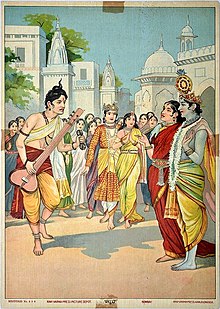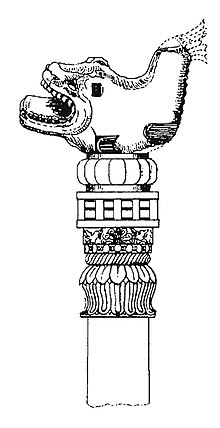Pradyumna
| Pradyumna | |
|---|---|
 An 18th-century Pahari painting of Pradyumna (right) battling with demon Shambara | |
| Affiliation | Vaishnavism |
| Abode | Dvaraka |
| Texts | Mahabharata, Srimad Bhagavatam, Harivamsa |
| Genealogy | |
| Parents | |
| Spouse | Mayavati Rukmavati Prabhavati[1] |
| Children | Aniruddha |
| Dynasty | Yaduvamsha |
| Vrishni heroes |
|---|
 |
| Part of a series on |
| Vaishnavism |
|---|
 |

Pradyumna (Sanskrit: प्रद्युम्न, lit. 'the eminently mighty one') [2] is the eldest son of the Hindu deities Krishna and his wife , Rukmini.[3] He is considered to be one of the four vyuha avatars of Vishnu. According to the Bhagavata Purana, Pradyumna was the reincarnation of Kamadeva, the god of love. The Mahabharata states that Pradyumna was a portion of Sanat Kumara.[4]
The Harivamsa describes the chaturvyuha, consisisting of the Vrishni heroes Vāsudeva, Samkarsana, Pradyumna, and Aniruddha, that would later be the basis for the Vaishnava concept of primary quadrupled expansion, or avatara.
Pradyumna is also another name of the Hindu god Vishnu, mentioned to be one of the 24 Keshava Namas (names).
Birth and early life
[edit]
This section needs additional citations for verification. (May 2023) |
Pradyumna was the son of Krishna and the sixty-first grandson of Adinarayana. His mother was Rukmini, whom Krishna had eloped with from Vidarbha during her swayamvara on her request. Pradyumna was born in Dvaraka and was the reincarnation of the demigod Kamadeva, a deity who was burnt to ashes by the fury of Shiva.
According to the Bhagavata Purana, within 10 days of Pradyumna's birth, he was abducted by the asura Shambara. Recognising him as his foe, the asura threw him into the ocean. The infant was swallowed by a mighty fish, which was caught by fishermen and presented to Shambara. Shambara's cooks discovered the child upon cutting the fish open. The child was given to Mayavati, who was the earthly incarnation of Rati. Recognising the son of Krishna as her divine consort, Rati fell in love with him once more. Years passed until Pradyumna flowered into adolescence, raised by Mayavati. When chastised by the deity for her amorous notions towards him, she explained to him the circumstances of his new birth. She bestowed Pradyumna with the mystic art of mahamaya, which dispelled all magic. The youth then summoned the asura to battle, where the latter first attacked him with a club, and followed with his daitya magic. Hundreds of weapons belonging to guhyakas, gandharvas, pisacas, and uragas (celestial snakes) were amassed to combat him, but all fell before the son of Krishna. Drawing his sharp-edged sword, he beheaded the asura. Accompanied with his wife, he descended upon the palace in Dvaraka like a cloud with lightning, the crowds of noble women mistaking his handsome countenance and bluish-black curling locks for Krishna himself. Rukmini, however, recognised him as her own son. Krishna manifested himself to the scene along with Vasudeva and Devaki, and together with the residents of Dvaraka, embraced the couple and rejoiced.[5]
Marriages
[edit]
Pradyumna's first wife was Mayavati, the incarnation of Kamadeva's wife Rati. At first, Pradyumna objected, but upon explanation, he realised that she was, in fact, his eternal consort.[6] He also married Rukmavati, the daughter of his maternal uncle, Rukmi. It is said that Princess Rukmavati found his valour, comeliness, and charm beyond words, and insisted on marrying him at her swayamvara. With her, he fathered, Krishna's grandson and favourite, and also considered a vyuha avatar of Vishnu, Aniruddha. Prabhavati was an asura princess who fell in love with Pradyumna, and so he eloped with her.[7]
Role in Dvaraka
[edit]
Soon, Pradyumna became a constant companion of his father Krishna and was well-liked by the people of Dvaraka. Pradyumna was a mighty Maharathi warrior. He possessed the extremely rare Vaishnavastra, which was one of the most powerful weapons in the universe. He was one of the very few people to know the secret of the Chakravyuha. According to the Mahabharata, Pradyumna trained Abhimanyu and the Upapandavas in warfare when the Pandavas were in exile. But Pradyumna did not participate in the Kurukshetra War as he went on a pilgrimage with his uncle Balarama and the other Yadavas.[8] He was, however, an active participant in the Ashvamedha Yagna, which was later conducted by Yudhishthira.
Defence of Dvaraka
[edit]Pradyumna defended Dvaraka against Shalva, the king of the Shalva Kingdom, along with his father, uncle and brothers. In the Harivamsa, Pradyumna alone repelled the attack of Jarasandha.
Death
[edit]Pradyumna was later killed in an intoxicated brawl, along with all the other members of the Yadava clan. His grandson, Vajra, was the only survivor of Yadu lineage after this incident.[9]
Epithets
[edit]
One of the epithets of Pradyumna in literature, such as in Harivamsa 99, is "Makaradhvaja", meaning "he whose banner or standard is the crocodile".[16] A pillar capital with the effigy of a Makara crocodile found at Besnagar near the Heliodorus pillar dedicated to Vasudeva, is also attributed to Pradyumna.[16] In the Mahabharata, the Makara is associated with Krishna's son and Kamadeva, the God of Love, suggesting that they are identical.[16]
Descendants
[edit]As per the Bhagavata Purana, Canto 10, Chapter 61, Aniruddha was the son of Pradyumna and Rukmavati.[17] He was later abducted by Usha (daughter of Bana asura and granddaughter of Mahabali), who wished to marry him.[18] Usha's father, Banasura, however, imprisoned Aniruddha, creating a battle between Krishna and Shiva. In the battle, Pradyumna defeated Shiva's son Kartikeya, who fled on his peacock. At the end of the war, Banasura lost, and Aniruddha and Usha were married.[19] Aniruddha is said to have been very much like his grandfather Krishna, to the extent that some consider him to be a jana avatar, an avatar of Vishnu. Aniruddha's son was Vajra. Vajra was known to be an invincible warrior and was the only survivor of the Yadu Dynasty after the Yadus' battle. According to some sources, Vajra then had 16 idols of Krishna and other gods carved from a rare, imperishable stone called Braja and built temples to house these idols in and around Mathura so as to feel the presence of Krishna. It is said that Pradyumna and Arjuna were equivalent in their skills.
Texts
[edit]The Hindu version of the history of Pradyumna is mentioned in Bhagavata Purana and Hari Vamsa.
The Jain version of the story of Pradyumna is mentioned in the Pradyumna-charitra (poem in 18 canons) of Rajchandra, written in 1878 AD.[20]
| Vyūhas | Image | Attributes | Symbol[24][25] | Direction | Face | Concept | |||
|---|---|---|---|---|---|---|---|---|---|
| Narayana Vishnu |
Vāsudeva | Chakra Wheel Gadā Mace Shankha Conch |
Garuda Eagle | 
|
East | Saumya (Placid/ benevolent) |
Jṅāna Knowledge | ||
| Samkarsana | Lāṅgala Plough Musala Pestle Wine glass |
Tala Fan palm | 
|
South | Simha Lion | Bala Strength | |||
| Pradyumna | Cāpa Bow Bāṇa Arrow |
Makara Crocodile | West | Raudra Kapila | 
|
Aiśvaryā Sovereignty | |||
| Aniruddha | Carma Shield Khaḍga Sword |
Ṛṣya (ऋष्य) White-footed antelope | North | Varaha Boar | Śakti Power | ||||
References
[edit]- ^ "Story of Prabhāvatī". 28 January 2019.
- ^ "Srimad Bhagavatam: Canto 10 - Chapter 55". bhagavata.org. Retrieved 11 July 2022.
- ^ Books 8-12: Krishna, spirit of delight. Vighneswara Publishing House. 1976. p. 740.
- ^ "Srimad Bhagavatam: Canto 10 - Chapter 55".
- ^ "Srimad Bhagavatam: Canto 10 - Chapter 55". bhagavata.org. Retrieved 11 July 2022.
- ^ Benton, Catherine (1 June 2006). God of Desire: Tales of Kamadeva in Sanskrit Story Literature. SUNY Press. ISBN 978-0-7914-6566-0.
- ^ Ph.D, Lavanya Vemsani (13 June 2016). Krishna in History, Thought, and Culture: An Encyclopedia of the Hindu Lord of Many Names: An Encyclopedia of the Hindu Lord of Many Names. ABC-CLIO. ISBN 978-1-61069-211-3.
- ^ Saraswati, Swami Vidyanand. Droupadi Ka Chirharan Aur Shrikrishan (in Hindi). Kitabghar Prakashan. ISBN 978-81-88118-64-9.
- ^ "Srimad Bhagavatam: Canto 11 - Chapter 30".
- ^ Indian History. Allied Publishers. 1988. p. A-222. ISBN 978-81-8424-568-4.
- ^ a b Ayyar, Sulochana (1987). Costumes and Ornaments as Depicted in the Sculptures of Gwalior Museum. Mittal Publications. p. 13. ISBN 978-81-7099-002-4.
- ^ Gupta, Vinay K. (January 2019). "Vrishnis in Ancient Literature and Art". Indology's Pulse Arts in Context, Doris Meth Srinivasan Festschrift Volume, Eds. Corinna Wessels Mevissen and Gerd Mevissen with Assistance of Vinay Kumar Gupta: 81.
- ^ Austin, Christopher R. (2019). Pradyumna: Lover, Magician, and Scion of the Avatara. Oxford University Press. p. 24. ISBN 978-0-19-005412-0.
- ^ VIENNOT, Odette (1958). "Le Makara dans la Décoration des Monuments de l'Inde Ancienne : Positions et Fonctions". Arts Asiatiques. 5 (3): 184. JSTOR 43484068.
- ^ Visible in the back of the image entitled "Lion capital – Udayagiri – 5th century": "Gujari Mahal State Archaeological Museum – Gwalior". Kevin Standage. 15 April 2019.
- ^ a b c Austin, Christopher R. (2019). Pradyumna: Lover, Magician, and Son of the Avatara. Oxford University Press. p. 65. ISBN 978-0-19-005411-3.
- ^ "Srimad Bhagavatam: Canto 10 - Chapter 61".
- ^ "Srimad Bhagavatam: Canto 10 - Chapter 62".
- ^ "Srimad Bhagavatam: Canto 10 - Chapter 63".
- ^ Krishnamachariar 1989, p. 294.
- ^ Atherton, Cynthia Packert (1997). The Sculpture of Early Medieval Rajasthan. Brill. p. 78. ISBN 978-90-04-10789-2.
- ^ A Comprehensive History of India: pt. 1-2. A.D. 300-985. Orient Longmans. 1982. p. 866.
- ^ Parlier-Renault, Edith (2007). Temples de l'Inde méridionale: VIe-VIIIe siècles. La mise en scène des mythes. Presses Paris Sorbonne. pp. 38–42. ISBN 978-2-84050-464-1.
- ^ "A shrine of Aniruddha, the fourth of the 'vyuhas', which had within its precincts a 'rsyadhvaja', i. e. a column bearing on its top the figure of a 'rsya' or a white antelope which was his characteristic 'lanchana'." in Journal of the Indian Society of Oriental Art. Indian Society of Oriental Art. 1937. p. 16.
- ^ Gupta, Vinay K. "Vrishnis in Ancient Literature and Art". Indology's Pulse Arts in Context, Doris Meth Srinivasan Festschrift Volume, Eds. Corinna Wessels Mevissen and Gerd Mevissen with Assistance of Vinay Kumar Gupta: 80–81.
Sources
[edit]- Krishnamachariar, M. (1989) [1937], History of Classical Sanskrit Literature, Motilal Banarsidass, ISBN 81-208-0284-5

